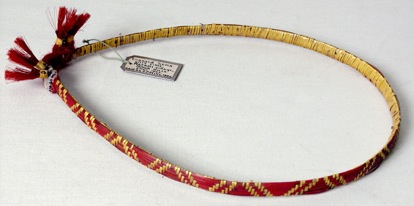Headband
Sema Naga people, Nagaland, India
 Collected by James Philip Mills in 1923 and donated by him in 1928; 1928.69.593The Naga people of northeastern India consist of around forty sub-groups. The groups share many customs but also possess individual cultural traditions and social structures. Both Phom and Sema Naga women wear woven headbands to keep their hair in intact and elegant.
Collected by James Philip Mills in 1923 and donated by him in 1928; 1928.69.593The Naga people of northeastern India consist of around forty sub-groups. The groups share many customs but also possess individual cultural traditions and social structures. Both Phom and Sema Naga women wear woven headbands to keep their hair in intact and elegant.
This headband, known as Aghu-u in Sema dialect, was worn by a girl betrothed for marriage. A splint of bamboo is thinned out and the two ends bound to form a circular shape. It is then decorated with plaited designs of red cane fibres and yellow orchid stem and finished with tufts of red-dyed goat's hair. Although Naga societies do not operate according to a class or caste system, ornaments are a way of signifying social status for both men and women and certain materials are considered powerful, the rights to wear them restricted.
Some Naga groups practise monogamy but the Sema are polygamous. A Sema husband may have as many as five to seven wives although the women have freedom of choice when it comes to selecting a husband and marriage-prices are high. Marriage is marked by a number of stages; what matters is not so much the exchange of gifts at the 'engagement' stage but the entry of the woman some time later into the man's house.
